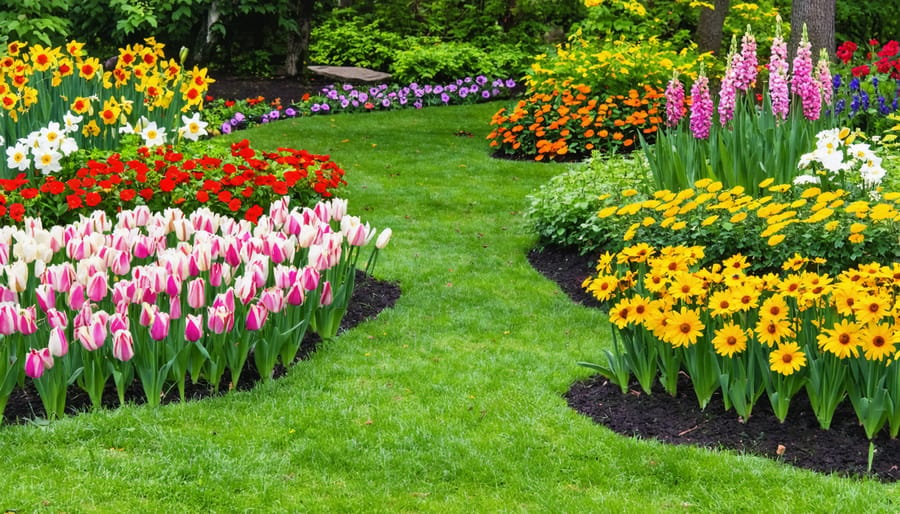Imagine a garden bursting with color, year after year, without the constant need for replanting. That’s the magic of a perennial flower garden! It’s an investment in beauty, a haven for pollinators, and a source of endless joy. But where do you begin? What are the secrets to creating a perennial paradise that thrives in your specific climate and soil? Let’s dive in and explore the wonderful world of perennial flower gardens!
What is a Perennial Flower Garden?
A perennial flower garden is a garden composed primarily of perennial plants. Unlike annuals, which complete their life cycle in one year and need to be replanted each spring, perennials live for more than two years. They die back to the ground in the winter and then re-emerge in the spring, bringing back their vibrant colors and textures. Think of it as a gift that keeps on giving!
Planning Your Perennial Flower Garden
Careful planning is key to a successful perennial garden. It’s not just about throwing a bunch of pretty flowers together. Consider these factors:
- Sunlight: How much sun does your garden receive? Choose plants that thrive in those conditions.
- Soil Type: Is your soil sandy, clay-rich, or somewhere in between? Amend it as needed to suit your chosen plants.
- Bloom Time: Select a variety of perennials that bloom at different times throughout the growing season for continuous color.
- Plant Height and Spread: Consider the mature size of your plants to avoid overcrowding.
- Hardiness Zone: Ensure the plants you choose are hardy in your region to survive the winter.
Choosing the Right Perennial Flowers
The possibilities are endless! From the stately beauty of delphiniums to the cheerful charm of daisies, there’s a perennial flower for every taste and garden style. Do you prefer vibrant hues or subtle pastels? Tall, dramatic blooms or low-growing groundcover? Think about the overall aesthetic you want to achieve.
Designing Your Perennial Flower Garden Layout
Think about layers! Place taller plants in the back and shorter plants in the front. Consider the color wheel and create pleasing color combinations. Don’t be afraid to experiment and have fun! A well-designed garden is a feast for the eyes.
Creating Visual Interest in Your Perennial Garden
Beyond color, consider texture and form. Mix plants with different leaf shapes and sizes to create visual interest. Add ornamental grasses for movement and height. Incorporate hardscaping elements like rocks or pathways to add structure and definition.
- Vary plant heights for a dynamic look.
- Use contrasting colors to create focal points.
- Repeat plant groupings for a sense of rhythm.
Maintaining Your Perennial Flower Garden
While perennials are relatively low-maintenance, they still require some care. Regular watering, weeding, and fertilizing will keep your plants healthy and thriving. Deadheading spent blooms encourages more flowering. Dividing overcrowded plants every few years will keep them vigorous;
Watering and Fertilizing Your Perennial Plants
Water deeply and less frequently, rather than shallowly and often. This encourages deep root growth. Fertilize in the spring with a balanced fertilizer. Avoid over-fertilizing, which can lead to leggy growth and fewer blooms.
Troubleshooting Common Perennial Flower Garden Problems
Even the most well-tended gardens can encounter problems. Be on the lookout for pests and diseases. Identify the problem early and take appropriate action. Don’t be afraid to ask for help from your local garden center or extension office.
Dealing with Pests and Diseases in Your Perennial Garden
Prevention is key! Choose disease-resistant varieties whenever possible. Practice good sanitation by removing dead leaves and debris. Use organic pest control methods whenever possible. A healthy garden is a resilient garden.
FAQ About Perennial Flower Gardens
- Q: What are the easiest perennials to grow?
A: Coneflowers (Echinacea), daylilies (Hemerocallis), and hostas are generally considered easy to grow and are great for beginners. - Q: How often should I divide my perennials?
A: It depends on the plant, but generally every 3-5 years is a good rule of thumb. You’ll know it’s time to divide when the center of the plant becomes less vigorous. - Q: Can I grow perennials in containers?
A: Yes! Many perennials thrive in containers. Just be sure to choose a pot that’s large enough for the plant’s mature size and use a good quality potting mix. - Q: When is the best time to plant perennials?
A: Spring or fall are generally the best times to plant perennials, as the weather is cooler and the plants have time to establish their roots before the heat of summer or the cold of winter.
Creating a perennial flower garden is a rewarding experience that brings beauty and joy to your life for years to come. It’s a journey of learning, experimentation, and connection with nature. So, get your hands dirty, embrace the process, and watch your garden flourish. Remember, every garden is unique, just like the gardener who tends it. Happy gardening!






